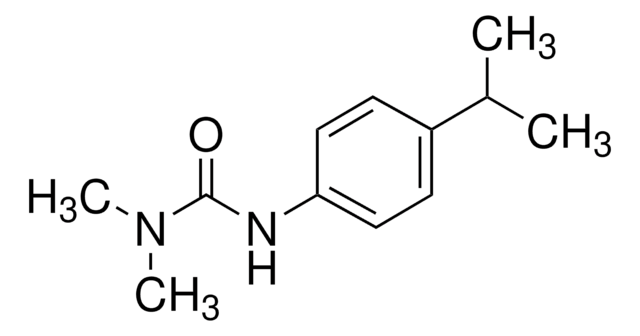Kluczowe dokumenty
36588
Simazine solution
100 μg/mL in methanol, PESTANAL®, analytical standard
About This Item
Polecane produkty
klasa czystości
analytical standard
Poziom jakości
linia produktu
PESTANAL®
okres trwałości
limited shelf life, expiry date on the label
stężenie
100 μg/mL in methanol
metody
HPLC: suitable
gas chromatography (GC): suitable
Zastosowanie
agriculture
cleaning products
cosmetics
food and beverages
personal care
format
single component solution
temp. przechowywania
2-8°C
ciąg SMILES
CCNc1nc(Cl)nc(NCC)n1
InChI
1S/C7H12ClN5/c1-3-9-6-11-5(8)12-7(13-6)10-4-2/h3-4H2,1-2H3,(H2,9,10,11,12,13)
Klucz InChI
ODCWYMIRDDJXKW-UHFFFAOYSA-N
Opis ogólny
Zastosowanie
Informacje prawne
Nie możesz znaleźć właściwego produktu?
Wypróbuj nasz Narzędzie selektora produktów.
produkt powiązany
Hasło ostrzegawcze
Danger
Zwroty wskazujące rodzaj zagrożenia
Zwroty wskazujące środki ostrożności
Klasyfikacja zagrożeń
Acute Tox. 3 Dermal - Acute Tox. 3 Inhalation - Acute Tox. 3 Oral - Flam. Liq. 2 - STOT SE 1
Organy docelowe
Eyes,Central nervous system
Kod klasy składowania
3 - Flammable liquids
Klasa zagrożenia wodnego (WGK)
WGK 2
Temperatura zapłonu (°F)
51.8 °F
Temperatura zapłonu (°C)
11 °C
Środki ochrony indywidualnej
Eyeshields, Faceshields, Gloves
Wybierz jedną z najnowszych wersji:
Masz już ten produkt?
Dokumenty związane z niedawno zakupionymi produktami zostały zamieszczone w Bibliotece dokumentów.
Protokoły
HPLC Analysis of Urea, Carbamate, Triazine, Aniline Pesticides on Discovery® C18
Separation of Atrazine-desethyl; Metoxuron; Hexazinone; Simazine; Cyanazine; Methabenzthiazuron; Atrazine; Monolinuron; Diuron; Isoproturon; Metobromuron; Metazachlor; Sebuthylazin; Linuron; Metolachlor
Nasz zespół naukowców ma doświadczenie we wszystkich obszarach badań, w tym w naukach przyrodniczych, materiałoznawstwie, syntezie chemicznej, chromatografii, analityce i wielu innych dziedzinach.
Skontaktuj się z zespołem ds. pomocy technicznej


